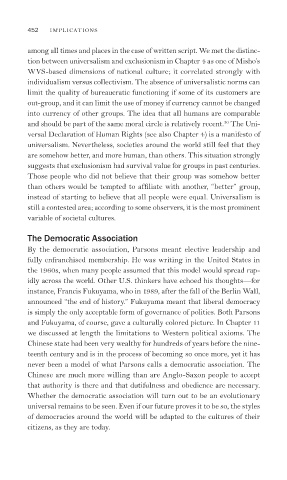Page 487 - Cultures and Organizations
P. 487
452 IMPLICATIONS
among all times and places in the case of written script. We met the distinc-
tion between universalism and exclusionism in Chapter 4 as one of Misho’s
WVS-based dimensions of national culture; it correlated strongly with
individualism versus collectivism. The absence of universalistic norms can
limit the quality of bureaucratic functioning if some of its customers are
out-group, and it can limit the use of money if currency cannot be changed
into currency of other groups. The idea that all humans are comparable
30
and should be part of the same moral circle is relatively recent. The Uni-
versal Declaration of Human Rights (see also Chapter 4) is a manifesto of
universalism. Nevertheless, societies around the world still feel that they
are somehow better, and more human, than others. This situation strongly
suggests that exclusionism had survival value for groups in past centuries.
Those people who did not believe that their group was somehow better
than others would be tempted to affiliate with another, “better” group,
instead of starting to believe that all people were equal. Universalism is
still a contested area; according to some observers, it is the most prominent
variable of societal cultures.
The Democratic Association
By the democratic association, Parsons meant elective leadership and
fully enfranchised membership. He was writing in the United States in
the 1960s, when many people assumed that this model would spread rap-
idly across the world. Other U.S. thinkers have echoed his thoughts—for
instance, Francis Fukuyama, who in 1989, after the fall of the Berlin Wall,
announced “the end of history.” Fukuyama meant that liberal democracy
is simply the only acceptable form of governance of polities. Both Parsons
and Fukuyama, of course, gave a culturally colored picture. In Chapter 11
we discussed at length the limitations to Western political axioms. The
Chinese state had been very wealthy for hundreds of years before the nine-
teenth century and is in the process of becoming so once more, yet it has
never been a model of what Parsons calls a democratic association. The
Chinese are much more willing than are Anglo-Saxon people to accept
that authority is there and that dutifulness and obedience are necessary.
Whether the democratic association will turn out to be an evolutionary
universal remains to be seen. Even if our future proves it to be so, the styles
of democracies around the world will be adapted to the cultures of their
citizens, as they are today.

